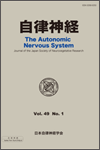
- Issue 2 Pages 43-
- Issue 1 Pages 2-
- |<
- <
- 1
- >
- >|
-
Tomohiko Nakamura2025Volume 62Issue 2 Pages 43-48
Published: 2025
Released on J-STAGE: June 30, 2025
JOURNAL FREE ACCESSParkinson’s disease is a progressive disorder that, in addition to motor symptoms, is accompanied by autonomic dysfunction, which becomes more pronounced as the disease progresses. Circulatory abnormalities such as orthostatic hypotension, supine hypertension, and nocturnal blood pressure abnormalities are closely associated with the development of dementia and the progression of white matter lesions, significantly impairing patients’ quality of life and life prognosis. These abnormalities, influenced by both vascular factors and the progression of neurodegeneration, exert a substantial impact on the entire body and the central nervous system, underscoring the importance of early diagnosis and appropriate intervention. This article provides an overview of the pathophysiology, diagnostic methods, associated factors, and clinical significance of circulatory abnormalities in Parkinson’s disease, based on the latest findings, and discusses directions for management and therapeutic strategies.
View full abstractDownload PDF (771K) -
Tatsuya Yamamoto, Ryuji Sakakibara2025Volume 62Issue 2 Pages 49-54
Published: 2025
Released on J-STAGE: June 30, 2025
JOURNAL FREE ACCESSThe lower urinary tract dysfunction (LUTD) and constipation are prevalent in patients with Parkinson’s disease (PD). Regarding LUTD, urinary storage dysfunction, such as overactive bladder symptoms, is commonly treated with antimuscarinic drugs or beta-3 adrenoceptor agonists. Impairment of the dopamine D1 receptor-mediated direct pathway and the medial prefrontal cortex, which are recognized as important centers for micturition control, may contribute to LUTD in PD patients. Although many PD patients suffer from constipation, evidence supporting the efficacy of newly developed laxatives is gradually accumulating. This review will provide an overview of the symptoms, diagnosis, therapy, and pathophysiology of LUTD and constipation in PD.
View full abstractDownload PDF (466K) -
Kazuo Chin2025Volume 62Issue 2 Pages 56-61
Published: 2025
Released on J-STAGE: June 30, 2025
JOURNAL FREE ACCESSSleep apnea and sleep-related hypoventilation disorders are main diseases in sleep-related breathing disorders (also called as sleep disordered breathing: SDB in Japan). The prevalence of SDB is very high in the former. There are 2 types of sleep apnea; central and obstructive sleep apnea. More than 90% of sleep apnea cases are obstructive sleep apnea (OSA). The prevalence of moderate OSA is high and estimated to be around 20% in males and 10% in post-menopause females. OSA induces intermittent hypoxemia and sleep fragmentation with arousals. Intermittent hypoxemia is supposed to induce oxidative stress, systemic inflammation and increases sympathetic nerve activity, while sleep fragmentation with arousals also induces systemic inflammation and increases sympathetic nerve activity. It is said that three main factors for OSA are obesity, aging and being male, but facial morphology such as micrognathia and retrognathia is a significant factor among East Asian peoples. While it is well known that OSA is a risk factor for hypertension and diabetes, recent reports have shown that hypertension or diabetes is a risk factor for OSA. Thus, the interrelationship between OSA and lifestyle-related diseases is an interesting area for research.
View full abstractDownload PDF (1699K)
-
Hiroaki Yamano, Kanna Seto, Emiko Senba2025Volume 62Issue 2 Pages 63-70
Published: 2025
Released on J-STAGE: June 30, 2025
JOURNAL FREE ACCESSWe investigated the effects of interval aerobic exercise (IAE) on the autonomic nervous function using pulse rate variability (PRV). PRV was measured before and after 12 minutes of IAE and continuous aerobic exercise (CAE) at both moderate and high intensities by 12 healthy young adults. We also recorded subjective fatigue level after each exercise. The PRV parameters used were LnLF, which reflects both the sympathetic and parasympathetic functions, SDNN, RMSSD, and LnHF, which reflects parasympathetic function, and LF/HF, which reflects sympathetic function. No significant changes in PRV parameters were observed before and after CAE at moderate intensity. After CAE at high intensity, SDNN, RMSSD, LnTP, LnLF, and LnHF were significantly reduced. After IAE, SDNN, LnTP, LnLF, and LnHF were significantly reduced. In addition, the subjective post-exercise fatigue level was significantly higher after CAE at high intensity than after CAE at moderate intensity and IAE. Since IAE can affect the autonomic nervous system function while reducing subjective fatigue, it may be useful as an alternative aerobic exercise for the purpose of regulating autonomic nervous system function.
View full abstractDownload PDF (993K) -
Sae Uchida, Daichi Morihara, Ryota Sakurai, Fusako Kagitani, Hiroyuki ...2025Volume 62Issue 2 Pages 71-77
Published: 2025
Released on J-STAGE: June 30, 2025
JOURNAL FREE ACCESSCardiovascular dysfunction has been suggested as a risk factor for olfactory dysfunction in older adults; however, the details remain unclear. This study investigated whether older adults with reduced cardiac autonomic function during orthostatic stress exhibit a lower olfactory discrimination ability. In total, 100 community-dwelling older adults living independently, and aged 60 years or older participated in this study. The cardiac autonomic function, which contributes to the baroreflex response, was assessed by evaluating the heart rate increase during the postural change from sitting to standing (i.e., ∆HRmax). Subsequently, the participants were divided into small and large response groups based on the average ∆HRmax. The olfactory function was evaluated by testing the ability to discriminate between similar-smelling odorants. The study compared the olfactory function of the participants with declining cardiac autonomic function, separately in the young-old (age < 75) and old-old (age ≥ 75) groups. The mean ∆HRmax was 8.1 ± 3.5 (mean ± SD) beats per minute. A significantly higher number of participants in the smaller ∆HRmax group than in the larger ∆HRmax group could not discriminate between odorants. This trend was evident in both age groups but was more pronounced in the old-old group. The present results revealed that older adults with a smaller heart rate response to standing have impaired olfactory function, especially after 75 years of age.
View full abstractDownload PDF (311K)
- |<
- <
- 1
- >
- >|